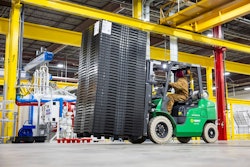
Global supply chain leaders’ key strategic priorities revolve around implementing new technology (51%), improving efficiency and productivity (40%) and building more resilient supply chains (29%), according to Blue Yonder’s “Supply Chain Compass” report.
“A consistent theme among surveyed leaders was the adoption of innovative solutions that deliver true end-to-end visibility across the supply network and enable a more connected, intelligence-driven approach to demand and supply planning,” says Andrea Morgan-Vandome, chief innovation officer, Blue Yonder. “In the face of ongoing economic uncertainty, geopolitical instability, and inflationary pressures, supply chain leaders are prioritizing technologies that enhance speed and precision. The report highlights that, beyond mitigating risk, decision-makers are increasingly exploring next-generation AI agents to advance sustainability goals and build supply chains that are not only faster but also more efficient.”
Key takeaways:
· Achieving each strategic priority over the next three years will require specific actions, and respondents identified better demand planning (46%) and quickly obtaining and analyzing data on performance (46%) as two of the top actions they believe are essential to success. This was followed by investing in tracking and visibility solutions (45%), digital software transformation and innovation (41%) and managing supply chain costs (33%).
· Many leaders across industries are actively witnessing the transformative power that new technology can bring, with 74% agreeing that AI is already changing the way their business operates. A staggering 82% of leaders agree that outdated technology will hinder their supply chain’s potential, and 51% state that implementing new technology is a top priority in the next three years.
· Supply chain leaders are willing to invest in technology, with 89% of decision-makers dedicating a specific budget to new supply chain technologies. For 61% of respondents, the budget for supply chain technology is between $1–$10 million across the next five years.
· Generative AI is currently under-implemented compared to traditional AI, which is largely used for prediction and automation. The majority of respondents (83%) are using (or are implementing) AI-powered automation, and 78% said the same of machine learning and predictive AI. By contrast, just 36% are using or implementing generative AI.
· One in four companies indicated they are implementing generative AI, while only 16% said they have no plans at all for implementing generative AI-based solutions.
· Of those with no plans to implement generative AI, 51% said that their organization will prioritize a people-led approach over cutting-edge technology.
- Organizations with an expected technology budget lower than $500,000 for the next one to five years are significantly less likely to consider implementing generative AI.
- Organizations not currently using generative AI aren’t necessarily behind — they’re prioritizing other strategic initiatives, such as automating inventory management to drive efficiency.
- Businesses that focus on transportation, order management and execution and fulfillment are significantly more likely to be investigating the implementation of generative AI (46%), while those in logistics (16%) are behind the adoption curve with no plans to implement.
- Achieving more sustainable supply chains is top of mind for today’s leaders, with “sustainable” being the number one word used to describe the future of their supply chains by respondents. This rang true for nearly two-thirds (68%) of leaders who agree there is an onus on supply chain operators to help solve problems like waste and climate change. Organizations that chose sustainability as a top three strategic priority are far more optimistic about their business performance.
- Sustainable packaging (37%), reducing waste across manufacturing (30%), recycling (28%), renewable energy resources/green fuels (28%) and lower emissions from warehouses and facilities (27%).
- Data analytics for emissions tracking (22%), connected networks for efficient shipping (17%), reducing waste from expiration (13%) and better returns processing (12%).
- 26% believe that forecasting technology can improve efficiency and, in turn, sustainability efforts.
- Respondents who named sustainability as a Top 3 strategic priority are on the leading edge of technology and AI adoption: 94% say end-to-end data connectivity is fundamental to the success of their business (vs. 85% total), 80% say AI is already changing how they operate (vs. 74% total) and 61% say they are currently investigating generative AI.




















